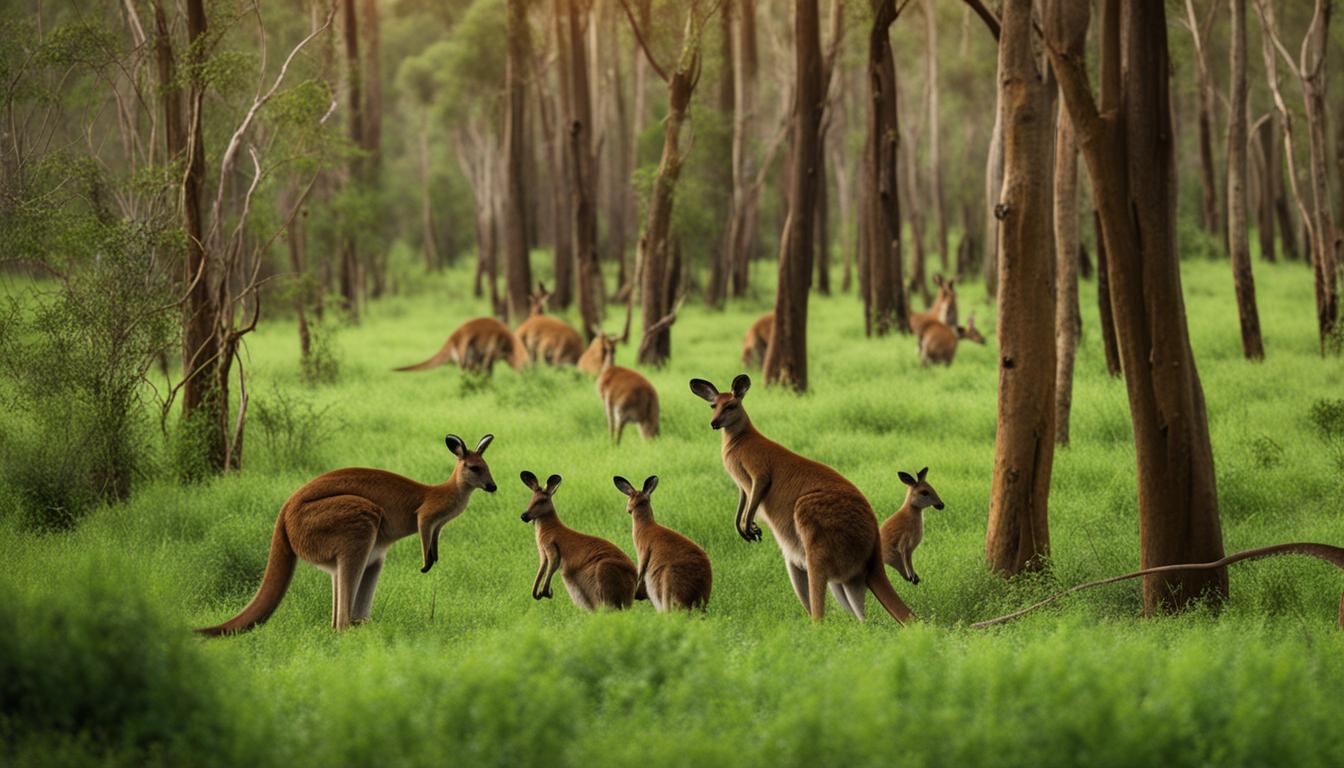In this article, we will explore the population size and statistics of kangaroos in the wild. These fascinating creatures are a beloved symbol of Australia and play a vital role in the country’s ecosystem. Let’s dive into the numbers and understand the current state of these iconic marsupials.
Table: Comparison of Kangaroo Population Control Methods
| Method | Effectiveness | Humaneness | Feasibility |
|---|---|---|---|
| Shooting | High | Considered humane when done following national standards and regulations | Feasible in areas with proper access and trained personnel |
| Fertility Control | Varies depending on implementation | Considered humane as it limits reproduction | Suitable in situations where shooting is not feasible |
| Fencing | Effective in controlling movement | N/A | Requires installation and ongoing maintenance |
These methods are used in combination to manage kangaroo populations, ensuring their conservation while also addressing the impacts of overpopulation. By implementing these strategies, authorities can strike a balance between the needs of the environment, agricultural practices, and the welfare of kangaroos.
Commercial Harvesting of Kangaroos
The commercial harvesting of kangaroos plays a significant role in managing their populations and contributing to Australia’s economy. This industry, valued at around 200 million Australian dollars per year, involves licensed hunters who earn fees for each kilogram of kangaroo harvested. The carcasses are then processed for their meat, skin, and hides, which are exported to over 70 countries.
Despite ongoing debates and controversies surrounding kangaroo harvesting, it is considered a necessary practice for population control and sustainable land management. The industry follows national standards and quotas set by state authorities. Commercial harvesting helps regulate kangaroo populations, preventing overpopulation and the associated risks, such as damage to farmland, property, and habitats.
“Commercial harvesting of kangaroos is crucial for maintaining a balance between conservation efforts and sustainable practices,” says Dr. Sarah Wilson, an expert in wildlife management at the Australian Wildlife Conservation Society.
“The industry provides economic incentives for landowners to manage kangaroo populations responsibly while ensuring the welfare of both the animals and the environment.”
| Year | Total Kangaroo Harvest |
|---|---|
| 2018 | 2,500,000 |
| 2019 | 3,100,000 |
| 2020 | 2,800,000 |
Commercial Harvesting Trends
Over the past three years, the commercial kangaroo harvesting industry has witnessed slight fluctuations in the total kangaroo harvest. In 2019, the harvest reached its highest point at 3.1 million kangaroos, showcasing a steady increase from the previous year. However, in 2020, the harvest decreased slightly to 2.8 million kangaroos. These figures reflect the management efforts and quotas established by state authorities.
It is important to note that the kangaroo harvest numbers are closely monitored and regulated to ensure the long-term sustainability of kangaroo populations. State authorities work in collaboration with wildlife experts and conservation organizations to set quotas that prioritize the welfare of the animals and maintain healthy population levels.
The commercial harvesting of kangaroos remains an integral part of Australia’s wildlife management strategies, aiming to strike a balance between population control, economic benefits, and conservation.
Controversies surrounding kangaroo harvesting
The practice of kangaroo harvesting is a topic of ongoing debate and controversy. Animal rights activists argue that it is cruel and driven by commercial interests, leading to the suffering and exploitation of these iconic Australian animals. They advocate for a ban on kangaroo products, including meat and leather, to protect the welfare of kangaroos and preserve their natural habitats.
Some companies have already taken a stance against kangaroo harvesting. Nike and Puma, for example, have phased out the use of kangaroo leather in their products, responding to consumer concerns and ethical considerations. This shift reflects a growing trend of consumers demanding greater transparency and sustainability in the fashion and footwear industries.
“Kangaroo harvesting is inhumane and unnecessary. We need to respect and protect these unique creatures, not exploit them for profit.” – Animal Rights Activist
On the other hand, supporters of kangaroo harvesting argue that it is necessary for population control and sustainable land management. They highlight the economic benefits of the industry, which contributes around 200 million Australian dollars per year to the national economy. Proponents emphasize that kangaroo populations need to be managed to prevent overpopulation, which can lead to habitat degradation, starvation, and threats to other native species.
Environmental Impact
An important aspect of the kangaroo population debate is its environmental impact. Critics argue that the large-scale harvesting of kangaroos disrupts ecosystems and biodiversity, affecting not only kangaroos but also other flora and fauna. They raise concerns about the long-term sustainability of kangaroo populations in the face of habitat loss, climate change, and other environmental pressures.
Sustainable Solutions
Seeking a middle ground, some experts and organizations advocate for more sustainable solutions in kangaroo population management. This includes improving welfare standards for harvested kangaroos, implementing stricter regulations, and exploring alternative industries that promote conservation and cultural heritage without compromising animal welfare.
| Pros of Kangaroo Harvesting | Cons of Kangaroo Harvesting |
|---|---|
|
|
As the debates surrounding kangaroo harvesting continue, finding sustainable solutions and striking a balance between conservation, cultural significance, and ethical practices remains a complex challenge.
The perception of kangaroos in Australian culture
In Australian culture, kangaroos hold a deeply rooted significance and are considered a national symbol. They are featured prominently in the country’s coat of arms, representing the unique wildlife and natural heritage of Australia. The kangaroo’s depiction on currency further reinforces its cultural importance, serving as a constant reminder of the country’s identity and connection to the land. The image of a kangaroo bounding through the outback embodies the spirit of freedom, resilience, and adaptability that Australians often associate with themselves.
The cultural significance of kangaroos extends beyond their representation in national symbols. They have been embraced as mascots for various organizations, sports teams, and events, showcasing the country’s pride in its native wildlife. The kangaroo’s strong and agile nature is often associated with attributes such as strength, courage, and determination, making it an ideal symbol for many aspects of Australian identity.
“The kangaroo is not just an animal in Australia; it is a part of our cultural heritage. It represents our unique wildlife and the spirit of the outback. Kangaroos are deeply ingrained in our culture, from our symbols to our stories, and they hold a special place in the hearts of Australians.” – Australian cultural historian
However, the cultural significance of kangaroos also raises questions about their ethical treatment and conservation. While they are admired and celebrated, there is an ongoing debate about the appropriate management of kangaroo populations and the impact of commercial harvesting. Striking a balance between preserving their cultural symbolism and ensuring their long-term sustainability is a complex challenge that requires careful consideration of both cultural values and ecological factors.
The cultural significance of kangaroos in Australia
The cultural significance of kangaroos in Australia is not solely based on their iconic status as a national symbol but also on their presence in storytelling, art, and indigenous culture. Aboriginal Dreamtime stories often feature kangaroos, highlighting their importance in the spiritual and cultural beliefs of Australia’s indigenous peoples. Kangaroos have also been depicted in various art forms, ranging from ancient rock art to contemporary paintings, further emphasizing their significance in the country’s artistic heritage.
| Cultural Significance | Description |
|---|---|
| Spirituality | Kangaroos have a spiritual significance in Aboriginal Dreamtime stories, representing various qualities such as strength, survival, and connection to the land. |
| Art and Literature | Kangaroos have been a subject of inspiration for artists and writers throughout Australian history, depicting their unique characteristics, beauty, and cultural symbolism. |
| Sport | Kangaroos are often associated with Australian sports teams, representing national pride and sportsmanship. |
| Tourism | Kangaroos attract tourists from around the world, offering a unique wildlife experience and contributing to the country’s tourism industry. |
The future of kangaroo populations
The management of kangaroo populations will continue to be a complex issue in the future. Balancing commercial interests, sustainable land management, and animal welfare concerns is crucial. Ongoing research and monitoring are necessary to ensure the long-term sustainability of kangaroo populations and their habitats.
Kangaroos play a vital role in Australia’s ecosystem, and their population dynamics have a significant impact on the environment. As human populations continue to grow and habitats are further encroached upon, the future of kangaroo populations depends on effective conservation strategies.
To ensure the sustainability of kangaroo populations, it is essential to focus on three key areas: population management, habitat preservation, and public awareness. Implementing responsible population control measures, such as carefully considered culling programs, can help prevent overpopulation and its ecological consequences.
Habitat preservation is equally critical. Protecting and restoring the natural habitats of kangaroos will provide them with sufficient resources and space to thrive. This includes conserving both terrestrial and grassland habitats, as they are crucial for the survival of kangaroo populations.
Lastly, fostering public awareness and appreciation for kangaroos and their unique role in the Australian ecosystem is crucial for their long-term sustainability. Engaging the public through educational initiatives, wildlife conservation programs, and ecotourism can help promote a sense of responsibility and support for the conservation of kangaroo populations.
Current Challenges and Future Possibilities
| Challenges | Possibilities |
|---|---|
| Human population growth and habitat loss | Sustainable land management practices and habitat conservation efforts |
| Overpopulation and ecological imbalances | Responsible population control measures and wildlife management strategies |
| Public misconceptions and lack of awareness | Education and outreach programs to foster public understanding and support |
| Climate change and its impact on habitats | Adaptive management strategies to mitigate the effects of climate change |
The future of kangaroo populations is in our hands. By implementing sustainable practices, preserving their habitats, and raising public awareness, we can ensure that these iconic Australian marsupials continue to thrive for generations to come.
Conclusion
In conclusion, the kangaroo population in Australia is carefully managed to prevent overpopulation and ensure the welfare of both the animals and the environment. With approximately 36.5 million kangaroos and wallaroos in the wild, population control measures are necessary to prevent damage to farmland, property, and habitats, as well as to mitigate risks to human safety. The commercial harvesting of kangaroos plays a significant role in maintaining population sizes and contributes to the country’s economy.
While controversies exist around kangaroo harvesting, it remains an important industry that provides valuable resources such as meat, skin, and hides. Proponents argue that it is necessary for sustainable land management and population control. However, animal rights activists advocate for a ban on kangaroo products, emphasizing the ethical treatment and conservation of these iconic animals.
Looking to the future, the management of kangaroo populations will continue to be a complex issue. Striking a balance between commercial interests, sustainable practices, and the preservation of Australia’s cultural heritage is essential. Ongoing research and monitoring are crucial to ensure the long-term sustainability of kangaroo populations and their habitats, safeguarding these beloved creatures for generations to come.
How Many Kangaroos Are Killed by Their Natural Predators in the Wild?
It is estimated that the natural predators of kangaroos, such as dingoes and eagles, are responsible for the deaths of around 10% of the kangaroo population each year. These predators play a crucial role in maintaining the balance of the ecosystem by controlling the kangaroo population.
FAQ
How many kangaroos are left in the wild?
According to government surveys, there are approximately 36.5 million kangaroos and wallaroos in Australia that are subject to population control measures.
What is the impact of kangaroo overpopulation?
Overpopulation can result in damage to farmland, property, and habitats. It can also pose a risk to human safety and lead to food scarcity for other animals.
What methods are used for controlling kangaroo populations?
Several methods are employed, including shooting, fertility control, and fencing.
Is commercial harvesting of kangaroos allowed in Australia?
Yes, the Australian government allows commercial harvesting of kangaroos in six out of eight states and territories.
What are the controversies surrounding kangaroo harvesting?
Animal rights activists argue that it is cruel and driven by commercial interests, while supporters argue it is necessary for population control and sustainable land management.
What is the perception of kangaroos in Australian culture?
Kangaroos are considered a national icon and deeply integrated into Australian culture, appearing on the country’s coat of arms, currency, and logos.
What is the future of kangaroo populations?
Balancing commercial interests, sustainable practices, and conservation efforts is key to ensuring the long-term sustainability of kangaroo populations and their habitats.
What is the conclusion about kangaroo populations?
The management of kangaroo populations will continue to be a complex issue, and ongoing research and monitoring are necessary to ensure their welfare and the environment’s well-being.











